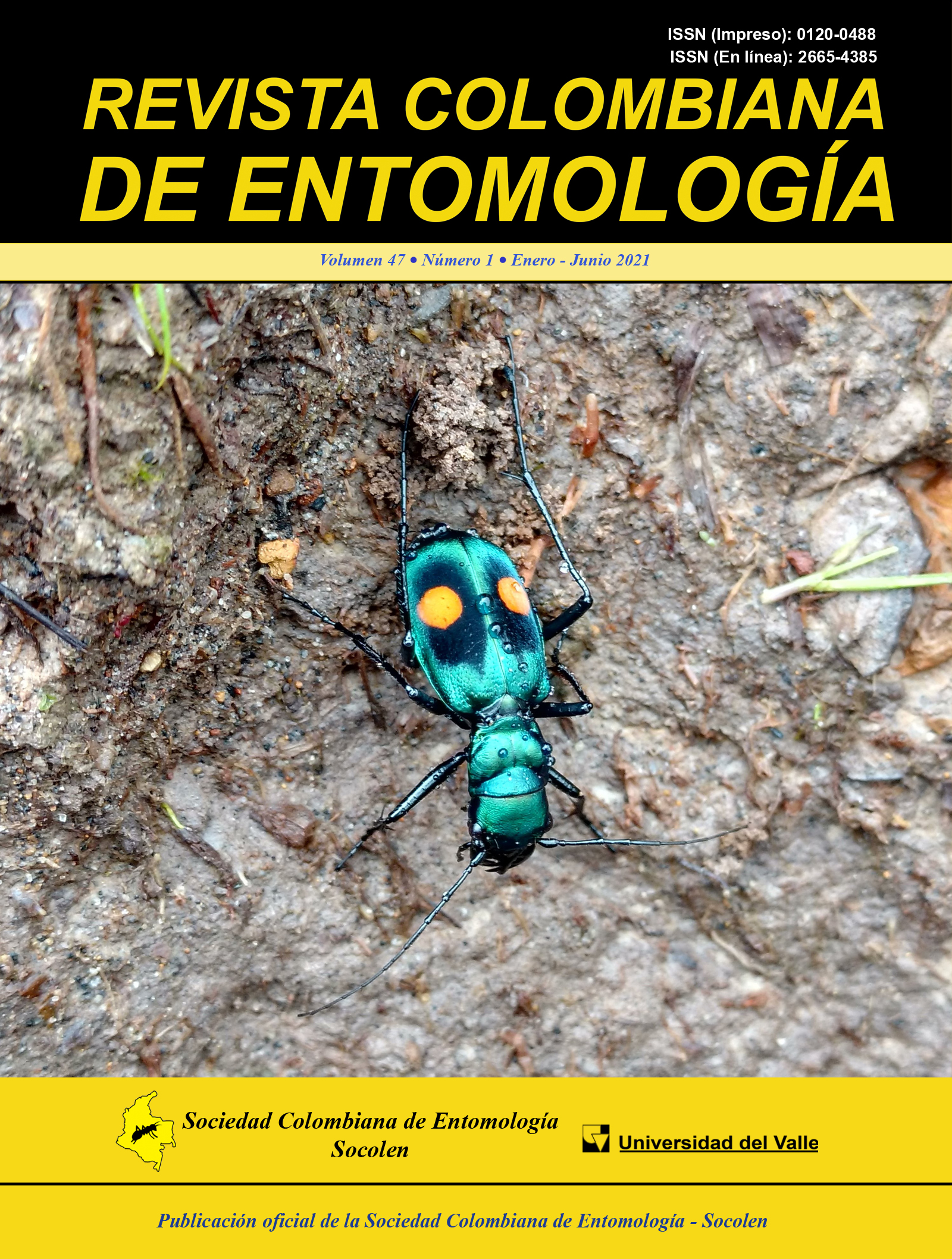Use of andiroba oil to control Anastrepha fraterculus (Diptera: Tephritidae) in different fruit hosts
Keywords:
Fruit flies, Extracts, Andiroba oil, Alternative controlMain Article Content
Control of Anastrepha fraterculus (Diptera: Tephritidae) is usually accomplished with synthetic insecticides, which can be a problem considering exportation of fruits. This study aimed to evaluate mortality and offspring effects on A. fraterculus using peach, strawberry guava and apple fruits treated with andiroba (Carapa guianensis) oil. Higher mortality rate was observed when compared to control on strawberry guava and apple fruits treated with andiroba oil (18.4 % and 35.0 % points more than the control). The mean number of pupae observed in the offspring was inferior to the control on strawberry guava and apple fruits treated with andiroba oil (100 % control) and, on peach fruits (68.3 % fewer pupae). Andiroba oil shows promising results as an alternative product to control A. fraterculus. Studies are still needed especially considering the effectiveness of andiroba oil under field conditions.
AMBROZIN, A. R. P.; LEITE, A. C.; BUENO, F. C.; VIEIRA, P. C.; FERNANDES, J. B.; BUENO, O. C.; SILVA, M. F. G. F.; PAGNOCCA, F. C.; HEBLING, M. J. A.; BACCI-JR, M. 2006. Limonoids from andiroba oil and Cedrela fissilis and their insecticidal activity. Journal of the Brazilian Chemical Society 17 (3): 542-547. https://doi.org/10.1590/S0103-50532006000300017
COSTA-SILVA, J. H.; LYRA, M. M. A.; LIMA, C. R.; ARRUDA, V. M.; ARAÚJO, A. V.; RIBEIRO E RIBEIRO, A. R.; ARRUDA, A. C.; FRAGA, M. C. C. A.; LAFAYETTE, S. S. L.; WANDERLEY, A. G. 2007. A toxicological evaluation of the effect of Carapa guianensis Aublet on pregnancy in Wistar rats. Journal of Ethnopharmacology 112 (1): 122-126. https://doi.org/10.1016/j.jep.2007.02.004
GRAMMATIKOPOULOS, G.; MANETAS, Y. 1994. Direct absorption of water by hairy leaves of Phlomis fruticosa and its contribution to drought avoidance. Canadian Journal of Botany 72 (12): 1805-1811. https://doi.org/10.1139/b94-222
GUAN, W.; LI, S.; YAN, R.; TANG, S.; QUAN, C. 2007. Comparison of essential oils of clove buds extracted with supercritical carbon dioxide and other three traditional extraction methods. Food Chemistry 101 (4): 1558-1564. https://doi.org/10.1016/j.foodchem.2006.04.009
HANDFORD, C. E.; ELLIOTT, C. T.; CAMPBELL, K. 2015. A review of the global pesticide legislation and the scale of challenge in reaching the global harmonization of food safety standards. Integrated Environmental Assessment and Management 11 (4): 525-536. https://doi.org/10.1002/ieam.1635
HIDAYAT, Y.; HEATHER, N.; HASSAN, E. 2013. Repellency and oviposition deterrence effects of plant essential and vegetable oils against female Queensland fruit fly Bactrocera tryoni (Froggatt) (Diptera: Tephritidae). Australian Journal of Entomology 52 (4): 379-386. https://doi.org/10.1111/aen.12040
ISMAN, M. B. 2006. Botanical insecticides, deterrents, and repellents in modern agriculture and an increasingly regulated world. Annual Review of Entomology 51: 45-66. https://doi.org/10.1146/annurev.ento.51.110104.151146
ISMAN, M. B. 2015. A renaissance for botanical insecticides? Pest Management Science 71 (12): 1587-1590. https://doi.org/10.1002/ps.4088
MIKOLAJCZAK, K. L.; WEISLEDER, D.; PARKANYI, L.; CLARDY, J. 1988. A limonoid antifeedant from seed of Carapa procera. Journal of Natural Products 51 (3): 606-610. https://doi.org/10.1021/np50057a033
MILHOMEM-PAIXÃO, S. S. R.; FASCINELI, M. L.; ROLL, M. M.; LONGO, J. P. F.; AZEVEDO, R. B.; PIECZARKA, J. C.; SALGADO, H. L. C.; SANTOS, A. S.; GRISOLIA, C. K. 2016. The lipidome, genotoxicity, hematotoxicity and antioxidant properties of andiroba oil from the Brazilian Amazon. Genetics and Molecular Biology 39 (2): 248-256. https://doi.org/10.1590/1678-4685-gmb-2015-0098
NUNES, M. Z.; BOFF, M. I. C.; SANTOS, R. S. S.; FRANCO, C. R.; ROSA, J. M. 2015. Control of the South American fruit fly in pear with natural-based products. Comunicata Scientiae 6 (3): 344-349. https://doi.org/10.14295/cs.v6i3.863
PIEPHO, H. P. 2012. A SAS macro for generating letter displays of pairwise mean comparisons. Communications in Biometry and Crop Science 7 (1): 4-13. http://agrobiol.sggw.waw.pl/~cbcs/articles/CBCS_7_1_2.pdf
PROPHIRO, J. S.; DA SILVA, M. A. N.; KANIS, L. A.; DA SILVA, B. M.; DUQUE-LUNA, J. E.; DA SILVA, O. S. 2012. Evaluation of time toxicity, residual effect, and growth-inhibiting property of Carapa guianensis and Copaifera sp. in Aedes aegypti. Parasitology Research 110 (2): 713-719. https://doi.org/10.1007/s00436-011-2547-5
ROMA, G. C.; CAMARGO-MATHIAS, M. I.; NUNES, P. H.; REMÉDIO, R. N.; FARIA, A. U.; BECHARA, G. H. 2015. Effects of andiroba (Carapa guianensis) oil in ticks: Ultrastructural analysis of the synganglion of Rhipicephalus sanguineus (Latreille, 1806) (Acari: Ixodidae). Acta Tropica 141: 7-15. https://doi.org/10.1016/j.actatropica.2014.06.018
ROSA, J. M.; BOFF, M. I. C.; GONÇALVES, P. A.; BOFF, P.; NUNES, M. Z. 2013. Andiroba oil (Carapa guianensis Aubl) in the capture of the fruit fly (Anastrepha fraterculus Wiedemann) in Feijoa (Acca sellowiana (Berg) Burret). Idesia 31 (3): 97-102. https://doi.org/10.4067/S0718-34292013000300013
SANTOS, A. C. V.; FERNANDES, C. C.; LOPES, L. M.; SOUSA, A. H. 2015. Use of plant oils from the southwestern Amazon for the control of maize weevil. Journal of Stored Products Research 63: 67-70. https://doi.org/10.1016/j.jspr.2015.07.002
SARRIA, A. L. F.; SOARES, M. S.; MATOS, A. P.; FERNANDES, J. B.; VIEIRA, P. C.; SILVA, M. F. G. F. 2011. Effect of triterpenoids and limonoids isolated from Cabralea canjerana and Carapa guianensis (Meliaceae) against Spodoptera frugiperda (J. E Smith). Zeitschrift für Naturforschung 66 (5-6): 245-250. https://doi.org/10.1515/znc-2011-5-607
SAS Institute Inc. 2015. SAS/IML® 14.1 User’s Guide. Cary, NC: SAS Institute Inc. https://support.sas.com/documentation/cdl/en/imlsug/68152/PDF/default/imlsug.pdf
ZUCCHI, R. A.; MORAES, R. C. B. 2008. Fruit flies (Diptera: Tephritidae) in Brazil. Anastrepha species their host plants and parasitoids. Department of Entomology and Acarology
ESALQ - University of São Paulo, Piracicaba, São Paulo, Brazil. Available in: http://www.lea.esalq.usp.br/anastrepha/ [Review date: 25 March 2018].
Downloads

This work is licensed under a Creative Commons Attribution-NonCommercial-ShareAlike 4.0 International License.
Authors retain the copyright on their work and are responsible for the ideas expressed in them. Once a manuscript is approved for publication, authors are asked for a publication license for the term of legal protection, for all territories that allows the use, dissemination and disclosure of the same.

